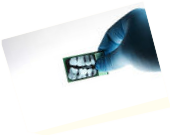Sometimes, if a tooth has been extensively damaged or decayed, or has become loose, there may be no alternative other than to remove it. Wisdom teeth frequently need removal as many people’s mouths are simply too small to accommodate four extra teeth. Although it may sound scary, tooth extraction is a routine procedure commonly performed by general dentists.
If Tooth Extraction is Required
We will need to take an x-ray of the affected tooth in order to plan its removal, as this shows us its proximity to other teeth, and will identify if any infection is present. 
If the extraction is straight forward, it is done under a local anesthetic, and is usually quite quick. Once the area has been numbed, the tooth is loosened using an instrument called an elevator, then it is removed using dental forceps.
After Oral Surgery
Once the tooth has been removed you may feel some mild discomfort which can generally be alleviated by taking over-the-counter painkillers. Removal of infected teeth may require a short course of antibiotics just to ensure all the infection is cleared.
If you have a complicated extraction, such as a wisdom tooth which is diseased or trying to erupt underneath adjacent teeth, then it may need to be performed by an oral surgeon.
Tooth extraction is usually very straight forward, and most healthy people will not suffer any complications.



